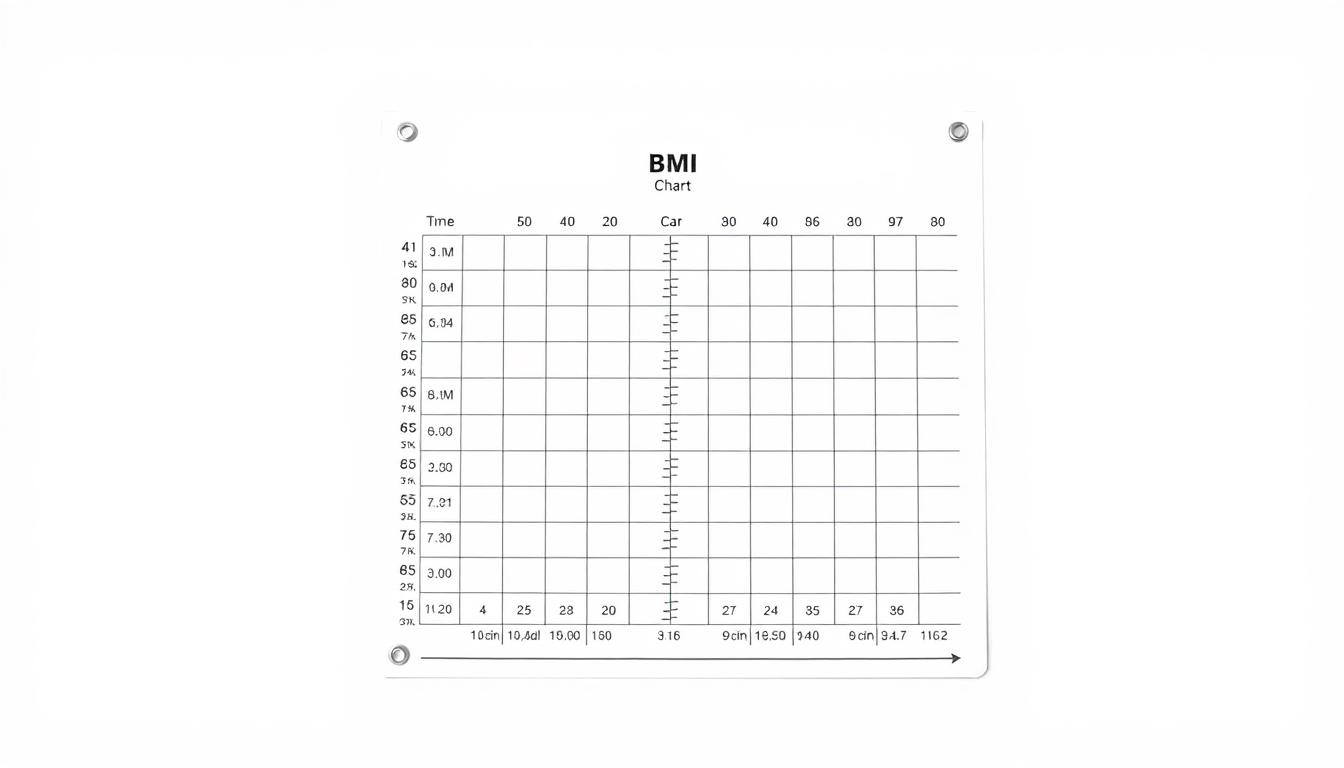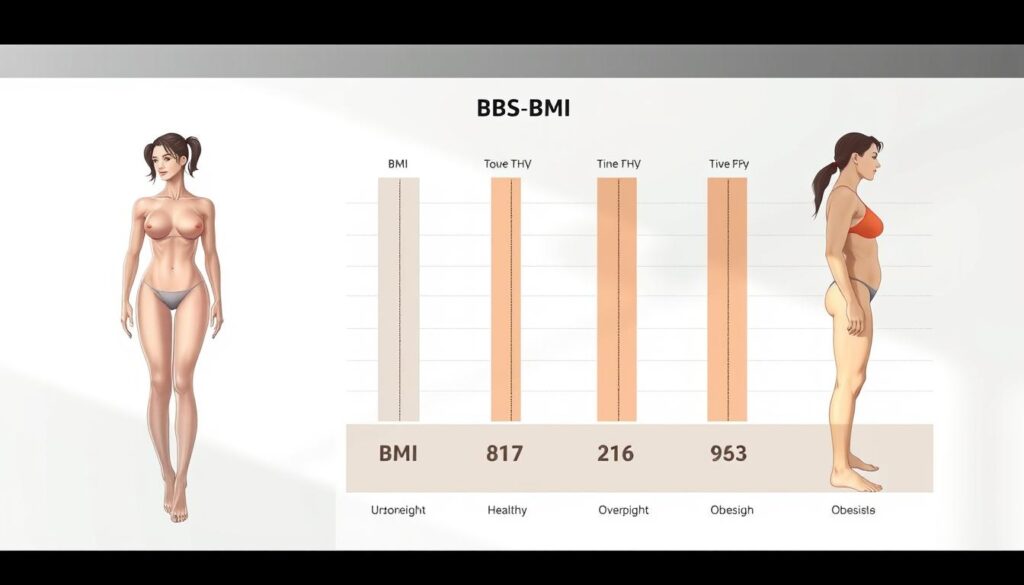Have you ever wondered if your weight truly reflects your overall wellness? For women standing at 5’6″, understanding body mass index (BMI) goes beyond numbers—it’s about connecting height, body composition, and health risks. This guide unpacks how BMI works, why it matters, and what your results mean specifically for your frame.
Experts like the CDC and Medical News Today stress that BMI remains a vital screening tool for adults. While it doesn’t measure body fat directly, it helps identify potential health concerns linked to weight. For 5’6″ females, the index offers a starting point to assess whether your mass aligns with medical recommendations.
This article explains how to calculate your 5 6 female BMI accurately using trusted methods. You’ll learn why factors like age and muscle mass influence results—and how to interpret them without stress. We’ll also share tips for maintaining a healthy range through sustainable habits.
Key Takeaways
- BMI provides a quick snapshot of weight-related health risks for adults.
- Accurate height and weight measurements are crucial for reliable results.
- The 5 6 female BMI range considers typical body compositions for this height.
- CDC-approved calculators ensure standardized assessments.
- Actionable advice helps translate BMI data into lifestyle improvements.
Overview of BMI and Its Role in Health
Why do health experts emphasize body mass index as a universal health marker? This simple calculation—weight divided by height squared—creates a snapshot of potential risks tied to excess fat. Leading institutions like the CDC classify it as a first-step screening tool for millions of people.
What is BMI and Why It Matters
A body mass index between 18.5 and 24.9 typically signals a healthy weight range. Medical News Today clarifies: “While it doesn’t measure body fat directly, it correlates strongly with metabolic risks.” For example:
- Values below 18.5 may indicate undernutrition
- Scores above 30 suggest obesity-related concerns
“BMI provides a standardized way to identify weight categories that could lead to heart disease or diabetes,” notes a CDC report.
Medical Insights from Leading Health Organizations
The American Cancer Society links high mass index scores to increased cancer risks. However, experts stress using waist measurements alongside BMI. Athletes with dense muscle might show inflated numbers despite low fat levels.
| BMI Category | Range | Health Risk Level |
|---|---|---|
| Underweight | <18.5 | Moderate |
| Normal | 18.5–24.9 | Low |
| Overweight | 25–29.9 | Elevated |
| Obese | ≥30 | High |
Modern bmi calculators simplify tracking, but they’re just one piece of the wellness puzzle. Pairing this index with blood pressure checks and activity assessments paints a fuller picture.
Understanding 5 6 female bmi Measurements
Determining where your weight stands relative to health benchmarks starts with precise calculations. For those measuring 66 inches tall, the process combines simple math with modern tools to gauge wellness effectively.
Step-by-Step Calculation Methods
To calculate BMI manually, convert weight in pounds and height in inches into a formula: (weight ÷ height²) × 703. For example, a 150-pound person at 66 inches tall would compute:
- 66 × 66 = 4,356
- 150 ÷ 4,356 = 0.0344
- 0.0344 × 703 = 24.2
Online tools simplify this process. Reputable calculators from the CDC or Medical News Today auto-fill categories after entering weight height details. These platforms reduce human error and deliver instant results.
Decoding Your Results Accurately
A score between 18.5–24.9 typically indicates a balanced ratio. Values below 18.5 may suggest inadequate nutrition, while numbers above 25 signal excess pounds linked to obesity risks. The CDC warns that sustained high scores correlate with heart strain and metabolic issues.
However, dense muscle mass can inflate results without reflecting actual fat levels. Active individuals might fall into “overweight” ranges despite low body fat—a reminder that BMI is one of many factors in health assessments.
“Always pair BMI with waist measurements and bloodwork for a complete picture,” advises a Medical News Today analysis.
Factors Influencing BMI and Overall Body Health
Body mass index tells part of your health story, but what fills in the gaps? Muscle distribution, hormonal shifts, and lifestyle habits all shape how weight interacts with wellness. The CDC emphasizes pairing BMI with waist measurements for clearer risk assessments—especially for active individuals or those navigating age-related changes.
Impact of Muscle Mass and Body Composition
Dense muscle weighs more than fat, which can push athletes into “high BMI” categories despite low body fat. A study cited by Medical News Today found weightlifters often show scores above 25 without elevated health risks. This highlights why doctors analyze waist size and activity levels alongside BMI charts.
For example, a person carrying extra weight around their midsection faces greater risk developing heart issues than someone with weight distributed evenly. Experts recommend tracking both height weight ratios and waist circumference for balanced insights.
Age, Menopausal Status, and Other Considerations
Hormonal shifts during menopause often redistribute fat to the abdomen, altering BMI accuracy. Research shows women over 50 may retain “normal” index scores while still facing metabolic concerns. The CDC advises combining BMI with blood pressure checks for these groups.
Targeted weight loss strategies—like strength training and balanced nutrition—help maintain muscle while reducing excess fat. As one clinical guideline states: “Focusing solely on BMI overlooks critical factors like bone density and organ health.”
“Waist measurements above 35 inches for women signal higher diabetes risks, even with average BMI values,” notes a Healthline analysis.
For precise evaluations, consult body composition charts that account for age and activity levels. This multidimensional approach empowers smarter health decisions beyond basic index numbers.
Practical Tips for Achieving and Maintaining a Healthy BMI
Building sustainable habits is key to balancing your weight and wellness. Focus on gradual changes that align with your body’s needs, supported by trusted health tools and strategies.
Diet and Nutritional Guidance
Prioritize whole foods like vegetables, lean proteins, and whole grains. The CDC recommends filling half your plate with colorful produce to boost fiber and reduce diabetes risks. Limit processed snacks and sugary drinks—swap them for nuts or Greek yogurt to stabilize energy levels.
Effective Exercise and Lifestyle Changes
Mix cardio and strength training to burn fat and maintain muscle. Studies show 150 minutes of weekly activity—like brisk walking or cycling—improves metabolic health. Small shifts, like taking stairs or standing desks, add up. The National Institutes of Health notes: “Consistency matters more than intensity for long-term results.”
Using BMI Calculators and Other Health Tools
Track progress with CDC-approved tools that factor in age and sex. Pair BMI checks with waist measurements for accuracy. For children, growth charts offer better insights than adult calculators. Regular blood sugar tests help spot early diabetes signs.
“Combining diet adjustments with activity changes yields better outcomes than focusing on weight alone,” states a Medical News Today review.
Update strategies as you age—muscle loss and hormonal shifts require tailored plans. Use apps to log meals and workouts, creating a clear picture of your health journey.
Conclusion
Health is more than numbers, yet metrics like BMI offer crucial insights for informed wellness choices. Understanding how weight interacts with height helps adults identify potential disease risks early. Staying within a healthy range supports heart health, energy levels, and long-term vitality.
Accurate measurements matter. Tools like the CDC-endorsed calculator simplify tracking while aligning with clinical guidelines. Pairing this information with waist size checks and bloodwork creates a clearer picture of overall health.
This content emphasizes actionable steps—balanced diets, regular activity, and consistent monitoring—to maintain wellness. Trusted sources like Medical News Today reinforce that BMI categories are starting points, not final verdicts. Always consult professionals to tailor strategies for your needs.
Remember: true health blends data with daily habits. By combining BMI insights with other metrics, you build a resilient foundation for lifelong well-being.




